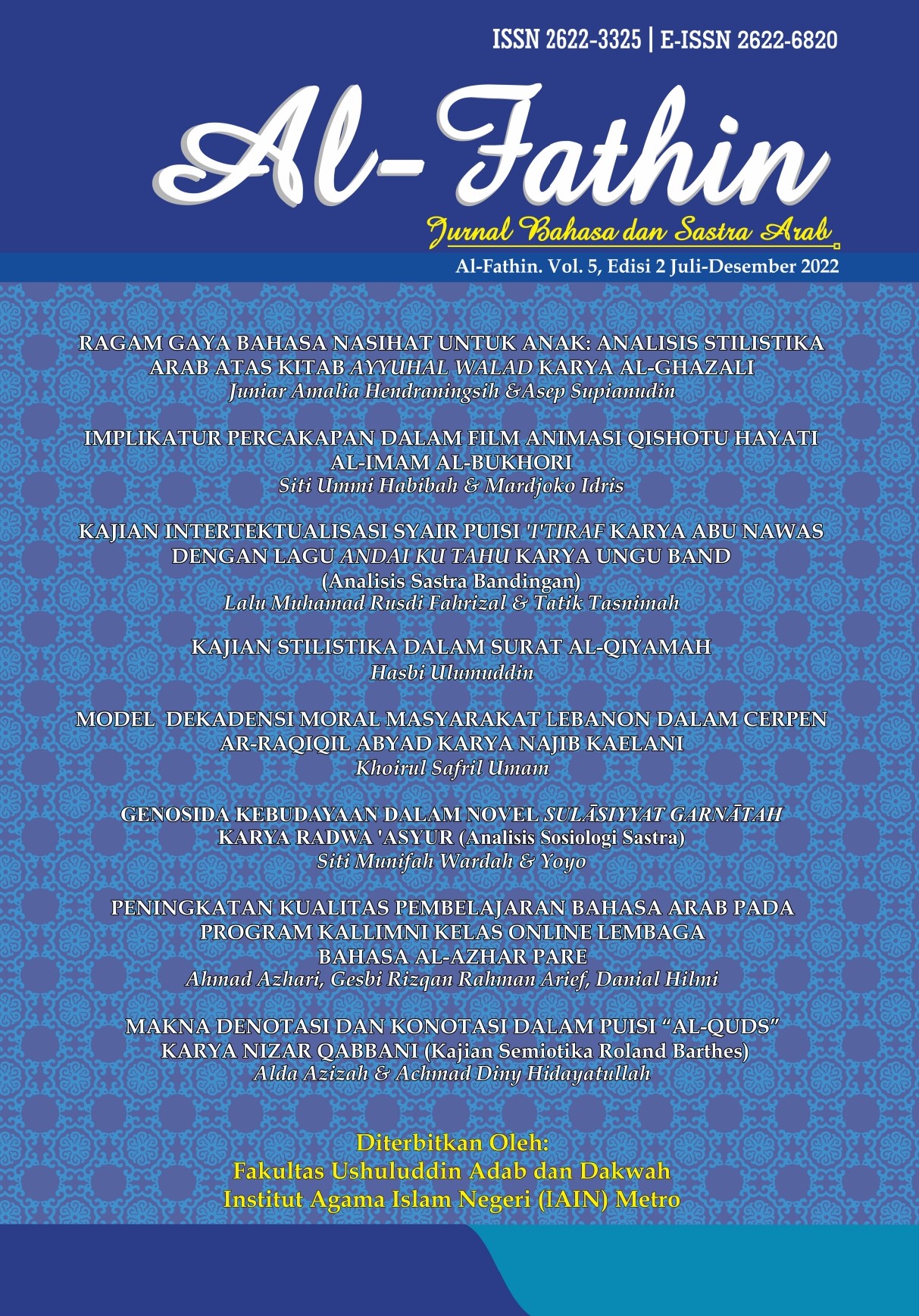Genosida Kebudayaan dalam Novel Ṡulāṡiyyat Garnāṭah Karya Radwa ‘Asyur (Analisis Sosiologi Sastra)
DOI:
https://doi.org/10.32332/al-fathin.v5i02.4887Keywords:
Andalusia, Cultural Genocide, Muslims, Radwa 'Asyur, Ṡulāṡiyyat GarnāṭahAbstract
This study aims to describe the forms of cultural genocide and the impacts that occur as a result of cultural genocide in the novel Ṡulāṡiyyat Garnāṭah by Radwa ‘Asyur. The study uses literary sociology of literature to reveal the correlation between the text and the context. The method used in this research is descriptive qualitative method. This study uses two data sources, namely primary data sources and secondary data sources. Primary data sources are in the form of narrative texts and conversations contained in the novel Ṡulāṡiyyat Garnāṭah, while secondary data sources are obtained from various literary sources in the form of books, journal articles, and theses. The data collection method used in the form of library research. The results of this study indicate that in the novel Ṡulāṡiyyat Garnāṭah there are 5 (five) forms of cultural genocide committed by Christians against Muslims, namely Christianization, destruction of Arabic manuscripts, prohibition of Islamic symbols, intimidation of Muslims, and deportation. Then there are 2 (two) impacts of cultural genocide, namely pretending to leave Islam and rebellion.
References
Ashour, Radwa. Granada. Bukumutu, 2008.
———. Mariama. Bukumutu, 2009.
As-Sirjani, Dr. Raghib. Bangkit Dan Runtuhnya Andalusia: Jejak Kejayaan Peradaban Islam Di Spanyol. Jakarta Timur: Pustaka al-Kautsar, 2013.
Asyur, Radwa. Ṡulāṡiyyat Garnāṭah. Mesir: Maktabah Usra, 2003.
Bachman, Jeffrey S. “An Historical Perspective: The Exclusion of Cultural Genocide from the Genocide Convention.” In Cultural Genocide, 45–61. Routledge, 2019.
Bilsky, Leora, and Rachel Klagsbrun. “The Return of Cultural Genocide?” European Journal of International Law 29, no. 2 (2018): 373–96.
Budiman, Arif. “Genosida Dalam Komik Footnotes In Gaza: Analisis Semiotika Charles S. Pierce,” 2019.
Car, Matthew. Blood and Faith: The Purging of Muslim Spain 1492-1614. Oxford University Press, 2017.
Dahlan, M. “Islam Di Spanyol Dan Sisilia,” Jurnal Rihlah, IV (2016).
Firdaus, Firdaus. “Islam Di Spanyol: Kemunduran Dan Kehancuran,” El Harakah, 11, no. 3 (2009).
Hartmann, Douglas, and Joseph Gerteis. “Dealing with Diversity: Mapping Multiculturalism in Sociological Terms.” Sociological Theory 23, no. 2 (2005): 218–40.
Ilham, Muhammad. “Runtuhnya Kerajaan Islam Di Granada 1492,” Pattingalloang, 3, no. 2 (2016): 110–26.
Mohammadzadeh, Hossien. “The Causes of Ethnic Conflict in Multi-Ethnic Societies.” World Scientific News 42 (2016): 156–66.
Mujahidin, Mujahidin. “Hubungan Sosial Budaya Islam Dan Kristen: Periode Pertengahan Dan Modern,” Al-Ma’arief: Jurnal Pendidikan Sosial dan Budaya, 1, no. 1 (2019): 1–10.
Nor, Mohd Roslan Mohd. “Sejarah Perkembangan Dan Kejatuhan Pemerintahan Islam Di Andalusia: Teladan Dan Sempadan,” Persatuan Ulama Malaysia, 2011, 13–29.
Rafileli, Rafileli. “Peradaban Islam Di Andalusia (Perspektif Sosial Budaya),” Tsaqofah dan Tarikh: Jurnal Kebudayaan dan Sejarah Islam, 2, no. 2 (2017): 153–66.
Varki, Ajit, Daniel H Geschwind, and Evan E Eichler. “Human Uniqueness: Genome Interactions with Environment, Behaviour and Culture.” Nature Reviews Genetics 9, no. 10 (2008): 749–63.










